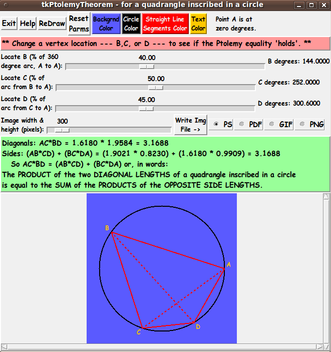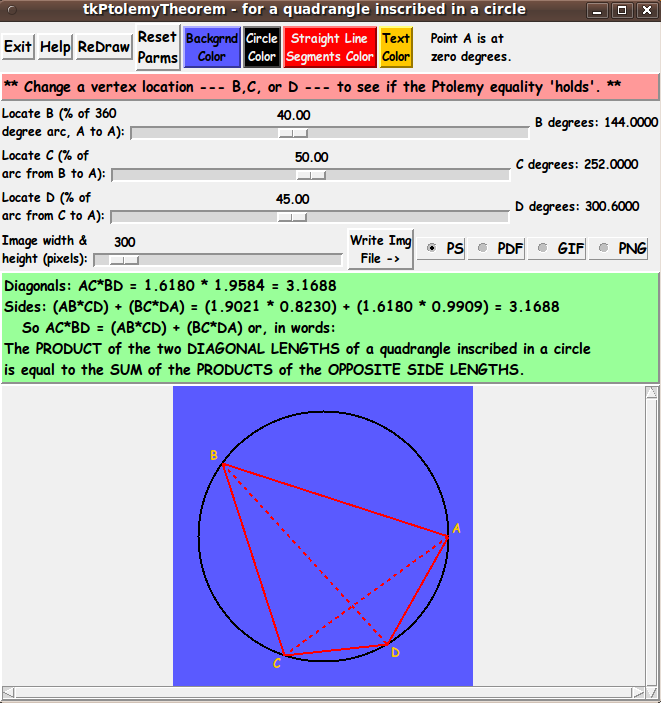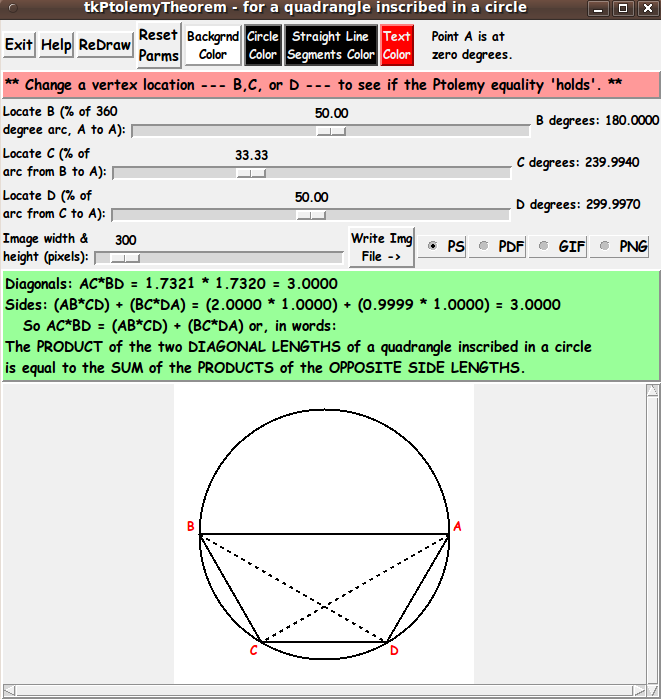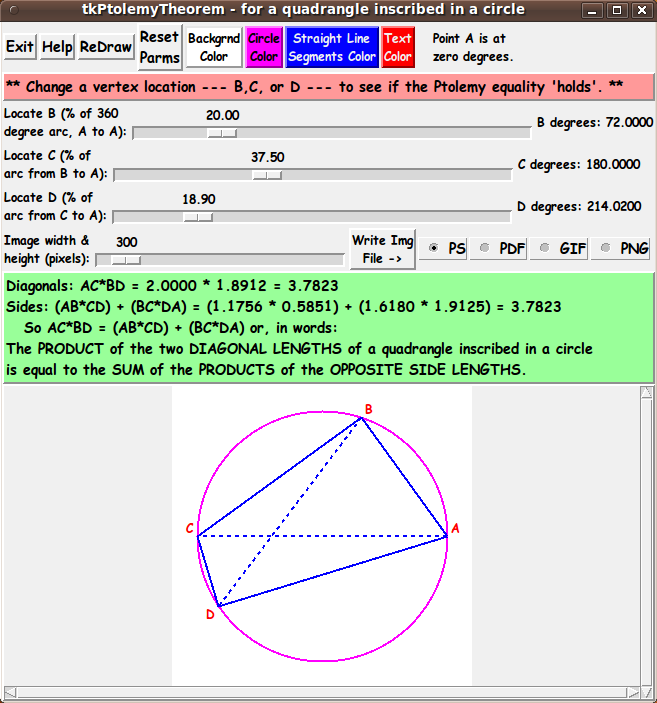|
INTRODUCTION to Tcl-Tk script
'tkPtolemysTheorem_QuadrangleInCircle'
In the 2013-2016 time frame, I started making some 'tkGooie'
scripts for a 'MATHed' (Mathematics Education) toolchest
--- scripts such as:
In my readings of various books popularizing math and, in particular, books containing
discoveries in plane (Euclidean) geometry, such as the book
I ran across static images representing the ancient Ptolemy's theorem
that says:
Given a quadrangle (alias quadrilateral) inscribed in a circle,
the product of the lengths of the two diagonals
is equal to the sum of the two products of
the lengths of the opposite sides.
There is a nice write-up of a proof of Ptolemy's theorem
in the last half of Chapter 6 of the book 'Trigonometric
Delights' by Eli Maor.
Maor points out that several other truths
of plane geometry and plane trigonometry are quick deductions
from Ptolemy's theorem --- including the Pythagorean Theorem
and the sine sum and difference formulas.
Although that book may not be readily available, you can
immediately see some pictures and discussion at the
Ptolemy's Theorem page at wikipedia.org.
How Ptolemy Used The Equation:
The book
'Great Calculations' by Colin Pask points out that
Ptolemy used this relationship to make a table of chord lengths
for angles between 0 and 180 degrees.
Ptolemy used the relationship (the equality) to
-
get the chord length subtending half an angle, given the chord
length subtending the original angle
AND
-
get the chord length subtending the difference of 2 angles,
given the chord lengths subtending the 2 angles.
Those two capabilities allowed Ptolemy to make a table of
chord lengths of at least 180 equally-spaced angles between
0 and 180 degrees.
Tables of chord lengths were the precursors of sine tables.
(In a unit circle, the length of a chord of an angle is twice
the sine of half the angle.)
There are many web sites with more information on Ptolemy's
theorem.
So if you want to see a variety of discussions
of this theorem, you can do a WEB SEARCH on keywords like
If you can deal with the annoying popups and advertisements, one web site
that is rife with math results is the 'Cut The Knot' site --- which has a page on
Ptolemy's Theorem
--- including reference to a proof done with complex numbers.
In any case, with the Tk script (whose code is presented on this page),
I was seeking to make the demonstration of the validity of Ptolemy's Theorem
an interactive and dynamic (semi-animated) experience --- using Tcl-Tk.
Around 2016, with the advent of Javascript enhancements associated with HTML 3.0,
some dynamic, interactive demos of math results started appearing on
the internet, such as the 'Wolfram Demonstrations Project'.
There is an animated demonstration of Ptolemy's Theorem at
demonstrations.wolfram.com.
In addition, the Wolfram 'MathWorld' site has a
'static image' page on
Ptolemy's Theorem.
One feature of the 'tkGooie' presented on this page
is that it comes bundled within a 'tkGooies'
menu-driven system that can be installed on a computer --- or on a
file server that serves files to multiple computers.
Another feature of the 'tkGooies' is that I generally provide more
control of colors than one sees in many math demo utilities.
Basic Goals of the Tk Script:
My purpose for this Tk GUI script is/was to generate a circle with a
quadrangle (alias quadrilateral) inscribed in the circle.
The user is to be able to easily change the position of the vertex
points of the quadrangle, around the circumference of the circle.
'Without loss of generality', we can fix one of the four points
and allow the user to move the other three.
To allow for pretty precise control in drawing these points, I decided
to use 3 Tk 'scale' widgets to adjust the position of 3 of the points
--- B, C, D --- counter-clockwise around the circle --- keeping point A fixed.
The drawings are to be done in a resizable square image area ---
in a Tk 'canvas' widget.
The GUI is to automatically delete-and-redraw (for the user) any changed
points --- which means that this utility is to delete-and-redraw the two
diagonals as well as the 4 sides of the quadrangle --- while also showing
that Ptolemy's equation holds no matter the position of B, C, and D.
PLANNED LAYOUT OF THE GUI:
As I have done with other Tk scripts that I have written in the past year or so,
I laid out a 'text image' of the GUI --- to aid me as I coded the frames
and widgets.
I used the following conventions to make the sketch, with a text editor.
|



